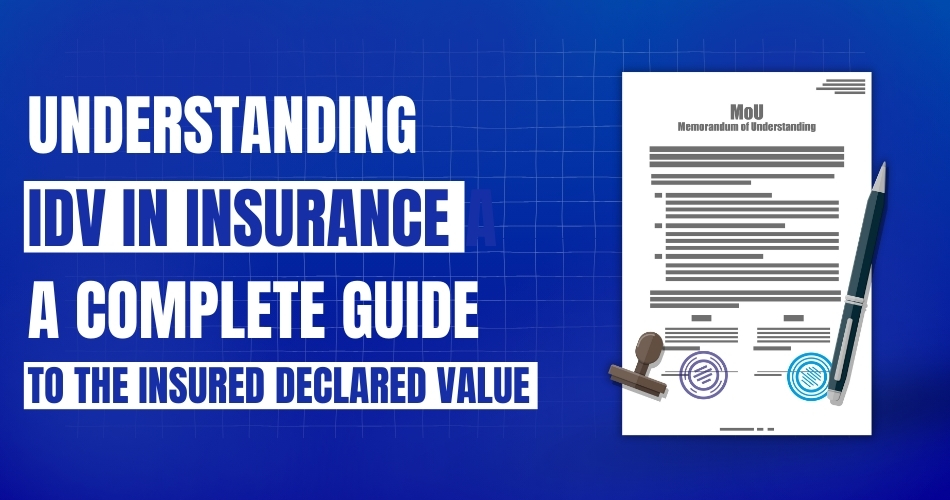As far as car insurance is concerned, one very important thing that any vehicle owner needs to know is the Insured Declared Value (IDV). IDV largely decides what compensation you will receive in case your vehicle is completely lost or stolen. To make things clearer, this lengthy guide will go on to define the concept of IDV and its calculation process, as well as several other variables that will dictate its worth.
What Is IDV in Car Insurance?
IDV is an abbreviation for the term insured declared value. It is the amount of money the insurance company will pay to you if your car is completely stolen or becomes worthless due to burglary. In other words, IDV is the current market value of your vehicle at the time of taking insurance. In case your vehicle is stolen or gets so damaged that it cannot be repaired, it’s the declared IDV that is used as the basis of determining how much the insurer will pay to you.
IDV is protection for the proposer as well as for the insurer. In case of the proposer, it ensures that the amount is reasonable and adequate according to the automobile value; in case of the insurer, it establishes how much liability can be incurred in case of a claim.
How Is IDV Determined?
This is not a simple figure to calculate as it comprises several factors that sum up to define the value of your vehicle in the market. Here’s how it is usually calculated:
Manufacturer’s Listed Selling Price : This is where you take off when calculating your IDV. It refers to what the manufacturer sells you the vehicle at.
Depreciation: Depreciation is an important element while computing IDV. The value of a car decreases with time due to wear and tear and the rates of depreciation vary with car age. The following standard rates of depreciation are more frequently applied:
| Year | Depreciation Rate |
|---|---|
| 1st year | 5% |
| 2nd year | 15% |
| 3rd year | 10% |
| 4th year | 10% |
| 5th year | 5% |
| After 5 years | 10% per year (flat rate) |
Vehicle Condition: The over condition of the car also determines the IDV. A better maintained car that has been serviced regularly and no major accidents may have a higher IDV compared to a poorly maintained car that may show evidence of neglect.
Market Trend: Demand in the market for your vehicle model will have an effect on the current market value. As a case in point, when demand in the market is high for a particular model, the value of that model will remain strong as compared to a model with low demand in the market.
Accessories: The IDV shall be affected by factory-fitted or highly valuable aftermarket fitted accessories. This can include additional features that help entrench safety on the vehicle, infotainment system among other modifications that add value to the car.
5 Factors that Affect the IDV of Your Car
Having knowledge about factors that affect IDV enables you with the ability to make informed decisions about your car insurance. There are five major factors that affect IDV as follows:
Vehicle Age: Just as illustrated above, age has wide influence in the devaluation of a car and, therefore, its IDV. Newer cars possess higher IDV compared to more aged ones.
Make and Model: Although some makes and models retain value far better than others. Luxury cars or limited editions may have a higher IDV than ordinary vehicles.
Vehicle Condition: Proper and correct care for your vehicle increases its IDV. Cars having an easy-to-trace service history and negligible wear may command a higher value.
Accessories: Factory fitted accessories normally add up to the IDV while aftermarket accessories are not always added in the calculation.
Market Trends: Trends in the automobile industry may vary. Having information about what trends are will allow you to determine the perfect IDV for your vehicle.
What if I Set a Lower IDV?
You might think that an IDV of lower costs will be interesting, considering it will save more money on premiums. That said, this might lead to serious damage once you take such a decision. Consider this:
Underinsurance risk: If you choose to have a low IDV, then there is the risk that you might be underinsured. The amount you will receive in case the vehicle gets totally damaged or stolen may not cover up the actual market value of the vehicle. This can put you in financial pressure when acquiring another car.
Settlement Issues with Claims: Insurers may reject claims or settle lower than the level declared by arguing that the declared IDV is not indicative of the car’s value. This further slows down settlement of claims and upsets the insured person.
What happens if I Set a Higher IDV?
Let’s look at the other side too. If you set a higher IDV, you may face some problems too. See below:
Higher Premium:
A higher IDV means a higher premium. While this will give you that satisfaction of compensation in case of a loss. You are paying a price for that and you have to determine that against the value of your vehicle.
No Further Reimbursement:
That is, insurance companies would pay you the declared amount of IDV only if your car lacks some or all of the declared IDV at the time of delivery. So if your car is valued less than the declared IDV, then the insurance company wouldn’t reimburse the extra amount.
When Can the IDV Be Recovered?
Knowing when the IDV can be recovered is quite important to every vehicle owner. The IDV is recovered in case:
If your vehicle is declared a total loss due to accidents or any other incidents in which expenditure for repairs exceeds IDV, the insurer pays up to the declared value.
Theft: In the case of your vehicle being stolen, the amount of IDV is payable after the confirmation by the insurer that your vehicle cannot be recovered.
One of the vital factors is that your IDV should always reflect the market value of your vehicle. Such that when those circumstances demand, the expenses do not incur any losses at all.
Busting the Myths Around IDV in Car Insurance
Like most insurance-related topics, there are several myths around IDV. Here, we break some of the common myths as below:
| Myth | Fact |
|---|---|
| A Higher IDV Ensures Total Recovery | During a claim, you receive only the actual market value of your vehicle, not more, even if a higher IDV is declared. Therefore, it’s essential to align your IDV with the current market value. |
| Always Reducing The IDV Is An Economical Practice | A lower IDV reduces your premium but increases financial risk in case of total loss, as you may need to cover additional costs to replace your vehicle. |
| IDV Matters Only for Costly Cars | IDV is crucial for all vehicles, as it determines the compensation amount in total loss situations. Thus, IDV is relevant for every car owner, not just for those with expensive cars. |
Correlation Between a Car’s IDV and its Insurance Premium Policy
This is a direct relationship between IDV and insurance premiums. The higher the IDV, the more the premium goes up. In calculating the premium, the insurance company establishes premiums based on the risk associated with providing coverage. The latter directly suggests that the riskier it is in terms of paying up on claims. The more the insurers charge for premiums.
On the other hand, a lower IDV will bring down your premium to a considerable extent. However, this, as has been discussed above, goes with the risk of being inadequately insured. It is thus important to draw out the perfect balance between an affordable premium and adequate coverage.
Conclusion
For every vehicle owner, an understanding of the concept of IDV is of prime importance. It actually affects your insurance cost and compensation if there is total loss or theft. Knowing what factors affect IDV, possible risks of choosing a low or high IDV. And dispelling some common myths will help you make the best decisions with regards to your car insurance. Make sure that your IDV is accurate to your market value vehicle so that your financial aspect is taken care of and you can drive with a clear conscience.

